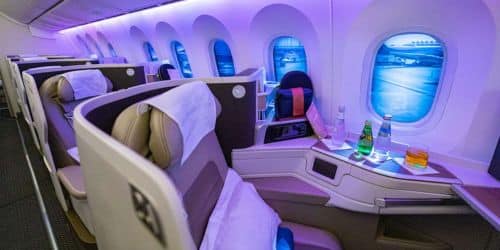If you’re sick of flying in economy, it might be time to consider an upgrade. Booking a premium cabin — that is, business class, domestic first class, or international first class — provides significant improvements for a more enjoyable flight. However, each cabin provides a unique experience, so it’s crucial to know what to expect from each. Here’s everything you need to know about the business class vs first class cabins that are now accessible on airlines.
Business Class vs First Class: Definitions, Pros & Cons
Business Class
This is a premium cabin available on long-haul international flights. Seats are often lie-flat or inclined rather than recliners, giving significantly more space than in economy or premium economy seats. Service is improved in the air and on the ground, with free booze to plated multicourse dinners and priority check-in and boarding to lounge access.
However, not all business-class accommodations are the same. Some older items lack seat comfort and privacy, but newer ones may offer closed-door suite-style seats with additional space. Even within an airline, business-class rooms on various planes vary substantially. Pricing is significantly more than economy, typically thousands of dollars regardless of route.
Pros
- Seats that are often lie-flat or angled
- Plated dining service with multiple courses
- Check-in and boarding priority
- Allowance for additional baggage
- Access to the lounge
- Kits of amenities
Cons
- Business class seating, amenities, and services differ substantially depending on the carrier and aircraft.
- An extremely costly alternative
- There are no free upgrades.
First Class
#1. Domestic First Class
On domestic and short-haul international flights, domestic first class is the deluxe cabin. Most airlines and aircraft will seat you in a recliner-style seat with more space and legroom than the economy. However, some transcontinental flights may have business-class lie-flat seats, which vary depending on the airline and aircraft.
On flights of several hours or more, you will be provided plated hot meals, and alcohol is complimentary. Priority check-in services (including increased baggage allowances) are provided beforebefore your trip, although lounge access is typically unavailable. You’ll be among the first passengers on your flight. The tickets are more expensive than the economy, but not as much as business-class costs – probably a few hundred to a thousand dollars.
Pros
- Seats that are more spacious and comfy
- Plated meals are frequently served.
- Allowance for additional baggage
- Check-in and boarding priority
- Upgrades are provided at no cost to elite status holders.
- Business or international first class is more costly.
Cons
- No lie-flat seats are available.
- Lounge access is not guaranteed.
#2. International First-class Travel
International first class is the ultimate flying experience – it’s the most incredible cabin on commercial aircraft, ranking above business class, and comes at a premium. Many carriers do not even offer international first class; Singapore carriers, Etihad, and Air France are among those who do. The spaciousness and seclusion of each seat are what distinguish the cabin. First-class seats on some carriers are private rooms with closed doors.
Fine wines and extravagant menu items elevate the dining experience above that of business class. As with business class, you’ll get several amenities on the ground, such as priority check-in and access to exclusive lounges – some airlines have dedicated first-class lounges that aren’t accessible to frequent fliers or business-class passengers. Also, anticipate to board in one of the first groups. This type of first-class cabin is only available on international long-haul flights — and only on specific routes operated by specific carriers.
Pros
- Most privacy, with some seats completely enclosed
- Upscale eating
- Check-in and boarding priority
- Allowance for additional baggage
- Some airports have first-class-only lounges, while others have open lounge access.
Cons
- Only on specific airlines and planes.
- The most costly option
- There are no free upgrades.
Domestic First Class vs. International First Class
Domestic and international first class could not be more different while sharing the same moniker, and if you’re expecting a lie-flat seat and gourmet food on a three-hour domestic first class flight, you’ll be disappointed.
The United States is one of the few countries where airlines routinely sell its domestic premium cabins as “first class”—on most shorter flights throughout the world, it’s business class. On most domestic US flights, first class includes a bigger reclining seat, enhanced (and free) dinner service, and free alcoholic drinks, often served on basic china with glassware, as opposed to the plastic used in economy (also known as the “main cabin” by carriers).
On most domestic flights in the United States, first class is the only premium cabin available. However, there are a few routes that airlines treat differently, primarily coast-to-coast transcontinental flights (NYC to LA, for example). The first-class offerings on those flights are frequently comparable to those found in overseas markets. This is usually made evident during the website’s booking sequence.
Confoundingly, many shorter international flights between the United States and Canada, Mexico, Central America, the Caribbean, and even the far north of South America employ the same aircraft as US domestic flights. The domestic first class cabin is frequently offered as business class on these flights (although with service standards generally comparable to domestic first class).
Long-distance international travel is an entirely different experience. When we talk of international first class, we usually mean intercontinental first class—traveling from the United States to the rest of the world outside of North America.
The Difference Between Business Class and First Class on an International Flight
In contrast to domestic flights, the highest luxury cabin on international flights is not always first class. Many airlines refer to their most premium cabin as business class and do not offer first class. Airlines that do provide first class may not have it available on every aircraft type or itinerary. One thing is consistent: on flights where it is available, first class is more expensive than business class.
The difference is in the particulars. The simplest approach to compare international business class to international first class is to think of business class as quite elevated but still useful, whereas first class is designed to be over-the-top opulent, with additions that are generally more about appearance than substance.
Most airlines that fly international first class cabins today do a good job of elevating the first class experience enough to justify the higher fare over business class, but they are careful not to make it too exclusive and expensive, or they will lose customers to private jet travel.
The principal modifications were a slightly larger seat, different china and glassware, an extra soup course, and an additional choice of main course just before United Airlines phased out United Global First in favor of their new United Polaris business class. Otherwise, their first and business class offerings were strikingly identical. That was an example of a product on its way out—most airlines that still run separate first and business cabins to overseas markets have kept their distinctions from one another.
Read Also: BEST TRAVEL APP FOR FLIGHTS: Best App for Flights, Hotels & What You Should Know
Some airlines that offer business class but not first class have business class products that are comparable to first class. Airlines who offer both products have an incentive not to make their business class cabins too identical to their first class cabins, since this could make them less competitive versus rival carriers’ business class goods.
It’s also worth noting that the availability of international first class is frequently restricted to a smaller set of cities with high demand—typically, cities with concentrations in the entertainment, banking, energy, and technology industries, which have corporate travel policies that allow for first class travel.
Los Angeles, San Francisco, New York, London, Paris, Singapore, Hong Kong, and Tokyo all provide first-class service. Business class is often accessible on a significantly broader range of nonstop flights.
Lounges for First Class vs. Business Class
Most airports on a first or business class passenger’s route provide access to a lounge.
Business class lounges contain comfortable lounging areas as well as workplaces, shower suites, a buffet with hot and cold meals, an open bar, quiet sections for naps, and children’s play facilities.
Airlines with an international first class cabin nearly always have their own first class lounge. First class lounges often provide similar amenities to business class lounges, but in a less congested, frequently quieter environment with more personalized service. In addition, instead of a buffet, first-class lounges frequently provide a restaurant-style eating experience.
For example, the Air France La Premiere lounge at Paris CDG has a restaurant with table service serving Alain Ducasse cuisine, whilst the business class lounge has a self-service buffet and bar.
In some smaller cities with few daily flights, the first class lounge could just be a part of the business-class lounge with better food and services. First class travellers in bigger cities can use a separate first class lounge managed by the airline or one of its alliance partners. Lufthansa provides a unique First Class terminal in Frankfurt, complete with private security screening and private car transfers to departure gates.
First-class travellers connecting from other cities can also use the membership clubs at the route’s stopovers. A customer flying American Airlines Flagship First from Tampa to London with a stopover in Miami might use the Admirals Club in Tampa and the dedicated Flagship First lounge in Miami.
Boarding in First Class vs Business Class
While business class passengers are among the first to board the plane, they must still wait at the terminal.
First-class guests are often led to the departure gate, either by a cart through the terminal or, at some airports, by a luxury automobile to planeside. First-class passengers may additionally have access to a dedicated jet bridge to the aircraft and may embark first or last.
A flight attendant will often direct business class passengers to their seats at the boarding door, whereas first class passengers will typically receive a more elaborate welcome, including being escorted to their seats, being introduced to the products onboard if they are unfamiliar, and having their flight preferences noted.
Seats in First Class vs. Business Class
With a few exceptions, premium cabin seats are divided into three types: recliner, lie-flat, and suite. There are subcategories inside each of these, but these are the fundamentals.
A recliner seat is similar to a living room recliner, having a wider seat and greater legroom than a standard seat, as well as a foot rest. A lie-flat seat reclines to 180 degrees and has plenty of surrounding storage, whereas a suite has privacy walls or drapes around it and occasionally even more space.
Suites are gradually becoming the standard in first and business class, and several airlines provide them in both. The main distinction between them is the quantity of personal space. On some airlines, first class suites are essentially larger versions of business class seats, but on others, the suites might be quite different.
Both first and business-class passengers on Cathay Pacific’s 777-300 have lie-flat seats, however, the first class seat is longer and wider. They both include linens from the organic company Bamford, but the first has a higher thread count, a variety of pillow kinds, and they’re prepared with a “calming pillow mist.”
Read Also: Flight Attendant: Definition, Job Description & Salary
On the Singapore Airlines A380, business class guests enjoy a semi-enclosed suite with a lie-flat seat, but first class customers have a room with a static bed and a separate armchair—truly a suite. Singapore Airlines even distinguishes this as “Suites” from first class on other flights.
Some airlines, on the other hand, continue to use older versions of first class items, such as first- or second-generation reclining seats in a 2-2 arrangement, where window seats do not have direct aisle access. These layouts are becoming increasingly unusual, but it’s always a good idea to check the website or contact SeatGuru for specific seat information and seat maps for the aircraft type intended to operate the route before to booking to avoid disappointment onboard.
Food and Beverage in First Class vs. Business Class
On some airlines, there isn’t much of a difference between first and business class lunch service. The difference on other airlines can be significant. Because even business class cabins can have a large number of passengers to feed at the same time, service flow will normally resemble that of economy class: flight attendants dispense beverages and pre-plated meals on trays from aisle carts at a predetermined service time. Most airlines will serve an appetizer and salad to business class guests before returning with another cart to serve main entrees.
Meals in first class are frequently plated onboard and provided on request rather than at a specified time. Tables are also more commonly set and dishes delivered individually rather than all together on a single tray.
Food is also of the highest quality in first class. Many airlines, including Lufthansa, Emirates, Etihad, Cathay Pacific, and Singapore Airlines, offer caviar with traditional garnishes and pour high-end Champagnes like Dom Perignon, Bollinger, Krug, and Laurent Perrier. Many airlines will boil eggs to order in first class (Cathay Pacific has a specially designed frying pan in first class galleys).
Some airlines also allow you to pre-order specific entrees. While both business and first class passengers normally have access to the service, the selection in first class is often more broad.
Other Differences Between First and Business Class Amenities
Airlines typically differentiate their amenity kits significantly between first and business class passengers. The first class amenity kits on SWISS contain products from the Swiss luxury spa brand La Prairie, whilst the business class amenity kits are developed by Victorinox and contain more basic items. On Air France, business class packages include Clarins products, while first class kits have Carita amenities. On British Airways, The White Company is in first place, followed by Elemis.
Along with amenity packs containing personal care products, many airlines provide pajamas to passengers in both first and business class on long-haul nighttime flights. Sizes and supplies are frequently limited, and first class passengers have first dibs.
Some airlines have placed standup bars onboard, but only first and business class customers have access to them.
Emirates stands apart by providing first-class passengers with onboard shower rooms on their A380 aircraft. The suites, which include Bvlgari bath items, can be reserved for 30 minutes (the water flow lasts only five minutes, but the remaining time is clearly displayed).
Service in First Class vs. Service in Business Class
Business class customers are often left to their own devices outside of specified meal and beverage hours. Many airlines who do not have a staffed standup bar onboard will have a self-service bar with beverages and food available on long-haul flights.
Some airlines provide larger hot snacks that can be purchased from flight attendants at any moment throughout the journey. This is occasionally available in business class, although it is significantly more common in first class.
On nighttime flights, several airlines will provide first-class passengers with turndown service. Flight attendants will make the seat into a flat bed by adding a mattress pad, extra sheets and pillows, and a bedside glass of water or other nighttime treat. Some airlines provide this service in business class if they do not provide a first class product, however it is unusual for airlines that provide turndown service in first class to also give it in business.
Airlines That Offer Both First and Business Class Services on International Flights
On long-haul flights, here’s an incomplete list of airlines that provide both a business class and an even more luxurious first class experience.
- Emirates
- The airline Air France
- All Nippon Airways is a Japanese airline.
- Singapore Airlines (SIA)
- Cathay Pacific Airlines
- Japan Airlines (JAL)
- Etihad Airlines
- Korean Airlines
- Lufthansa
- SWISS
- Oman Airlines
- Qantas
- British Airways
Which One Should You Pick? First Class vs. Business Class
The final decision, as with most travel gear, boils down to value. Travelers who have the money to spend and want an exceptional travel experience will likely find booking a first class ticket worthwhile; travelers who want a comfortable flight but aren’t drawn in by all the trappings of a first class ticket may find business class to be a better value.
For example, on a seven-hour overnight flight between New York and Paris, a traveler who wants to maximize sleep time may prefer to have a quick bite in the lounge and then sleep the entire flight, so the onboard service differences between business and first may be irrelevant (provided the traveler does not require the extra space of a first class bed to sleep well). However, on the roughly 13-hour straight flight from New York to Dubai, the extra space and amenities, in addition to a full night’s sleep, could easily be put to good use.
Travelers who want to fly international first class must also consider product retirement. International first class is becoming obsolete, with many international carriers limiting the types of aircraft and routes that offer it, or abolishing it entirely. Most US-based carriers have abandoned international first class in favor of business class seats, with American Airlines remaining the lone survivor.
How to Book Business Class, First Class Domestically, and Internationally
You’re probably aware that you can choose any of these classes instead of the economy cabin when booking a flight. You’re undoubtedly also aware that you may book seats in business or first class using either cash or miles.
However, some airlines allow you to inquire about upgrades to business or first class at the check-in counter or transfer desk at the airport. You will not receive a free upgrade, but you may receive a discounted fee, such as a few hundred dollars instead of a few thousand dollars. The price is set by the airline and varies depending on the route, capacity, and scheduling.
Some airlines now allow you to bid on premium cabin upgrades. You may be able to input the highest sum you’re willing to pay for an upgrade on your airline’s website, or you may need to call in your offer.
And, for frequent passengers who reach elite status on airlines, there are normally complimentary upgrades to domestic first class dependent on availability – you should request yours before the flight online or using your airline’s app.
Bottom Line
If you’re seeking for the ideal trip memory and have the money to spend, first class is an excellent choice. However, if you’re upgrading from economy, business class will definitely provide enough extra comfort and service to seem like a luxury.
Whatever cabin is ultimately selected, it goes without saying that a trip in international first or business class will be memorable—for all the right reasons.
Related Articles
- WHAT DAY ARE FLIGHTS CHEAPEST TO BOOK? All You Need To Know
- BEST MOTORCYCLE BRANDS: Top 21 Brands in the World for Beginners & Pros
- BUY NOW PAY LATER FLIGHTS: Top Airlines That Allow You To Book a Flight Without Paying
- UNITED AIRLINES LOGO: Meaning, History, and Why the Logo Was Changed
- DIFFERENCE BETWEEN BUSINESS CLASS AND FIRST CLASS EXPLAINED!






